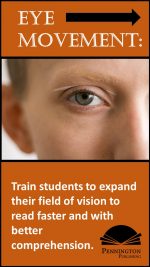Eye Movement and Speed Reading
Your eye movements in reading should have the same kind of automatic response as driving a car or word processing an e-mail. Training students to read faster helps build this automaticity by reducing line fixations and the amount of time spent on each fixation.
So, how do our eye movements affect our reading ability? Most people would probably say that their eyes follow the print, left to right, at a consistent rate across the page. However, this is far from the truth. Using sophisticated cameras and computer analysis, scientists have found that our eyes fixate on several places in the line in a rather herky-jerky motion.
In fact, when our eyes move, they aren’t even looking at the words, but are just moving from one fixation to the next. Eye movement accounts for only about one-tenth of the time spent on each line of reading text. In other words, reading consists of a series of individual glances at each line of text and the corresponding meaning-making of each glance.
The greater the number of fixations per line and the more time it takes to make sense of each fixation, the slower the meaning-making will be. Better readers have less fixations per line and rapid processing of each word. This is what Marilyn Adams (1995) refers to as “automaticity” and is the necessary prerequisite for reading well. This automatic processing develops as the reader becomes able to quickly and effectively apply the semantic, graphophonic, and syntactic cueing systems to the text.
Of course, the number of fixations per line and the duration of each fixation should depend on the degree of reading difficulty. Reading unfamiliar material or subject-specific vocabulary requires slower processing. Also, the purpose of the reader should determine reading speed. Reading a biology text for a test is quite different from reading a Goosebumps mystery for fun. The problem is that poor readers tend to read everything in the same way, that is with too many fixations and taking too much time to process the words.
Specific speed reading techniques have been developed to vary the reading rate according to the degree of text difficulty. Speed reading will also help call attention to, and even break, many poor reading habits. Effective speed reading will also maintain or improve reading comprehension as students increase their silent fluency rates.
*****
The Science of Reading Intervention Program
The Science of Reading Intervention Program: Word Recognition includes explicit, scripted instruction and practice with the 5 Daily Google Slide Activities every reading intervention student needs: 1. Phonemic Awareness and Morphology 2. Blending, Segmenting, and Spelling 3. Sounds and Spellings (including handwriting) 4. Heart Words Practice 5. Sam and Friends Phonics Books (decodables). Plus, digital and printable sound wall cards and speech articulation songs. Print versions are available for all activities. First Half of the Year Program (55 minutes-per-day, 18 weeks)
The Science of Reading Intervention Program: Language Comprehension resources are designed for students who have completed the word recognition program or have demonstrated basic mastery of the alphabetic code and can read with some degree of fluency. The program features the 5 Weekly Language Comprehension Activities: 1. Background Knowledge Mentor Texts 2. Academic Language, Greek and Latin Morphology, Figures of Speech, Connotations, Multiple Meaning Words 3. Syntax in Reading 4. Reading Comprehension Strategies 5. Literacy Knowledge (Narrative and Expository). Second Half of the Year Program (30 minutes-per-day, 18 weeks)
The Science of Reading Intervention Program: Assessment-based Instruction provides diagnostically-based “second chance” instructional resources. The program includes 13 comprehensive assessments and matching instructional resources to fill in the yet-to-be-mastered gaps in phonemic awareness, alphabetic awareness, phonics, fluency (with YouTube modeled readings), Heart Words and Phonics Games, spelling patterns, grammar, usage, and mechanics, syllabication and morphology, executive function shills. Second Half of the Year Program (25 minutes-per-day, 18 weeks)
The Science of Reading Intervention Program BUNDLE includes all 3 program components for the comprehensive, state-of-the-art (and science) grades 4-adult full-year program. Scripted, easy-to-teach, no prep, no need for time-consuming (albeit valuable) LETRS training or O-G certification… Learn as you teach and get results NOW for your students. Print to speech with plenty of speech to print instructional components.
SCIENCE OF READING INTERVENTION PROGRAM RESOURCES HERE for detailed product description and sample lessons.
Get the SCRIP Comprehension Strategies FREE Resource:
![]()
Get the Diagnostic ELA and Reading Assessments FREE Resource:![]()
Get the Syllable Awareness Assessment FREE Resource:
![]()
Get the Syllable Rules FREE Resource:
![]()
Get the Accent Rules FREE Resource:
![]()
Literacy Centers, Reading, Spelling/Vocabulary, Study Skills

